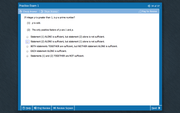Hi didieravoaka,
We're told that P is an INTEGER and that P > 1. We're asked if P is PRIME. This is a Yes/No question.
We can use a combination of TESTing VALUES and Number Properties to get to the correct answer.
1) P is ODD
IF....
P = 3
Then the answer to the question is YES.
IF...
P = 9
then the answer to the question is NO.
Fact 1 is INSUFFICIENT
2) The only positive factors of P are 1 and P
This Fact provides us with the actual definition of a Prime number. Prime numbers (2, 3, 5, 7, 11, 13, etc.) have JUST 2 factors - 1 and themselves. So when we're told that the only factors of P are 1 and P, then that means that P MUST be prime. The answer to the question is ALWAYS YES.
Fact 2 is SUFFICIENT.
Final Answer: B
GMAT assassins aren't born, they're made,
Rich

